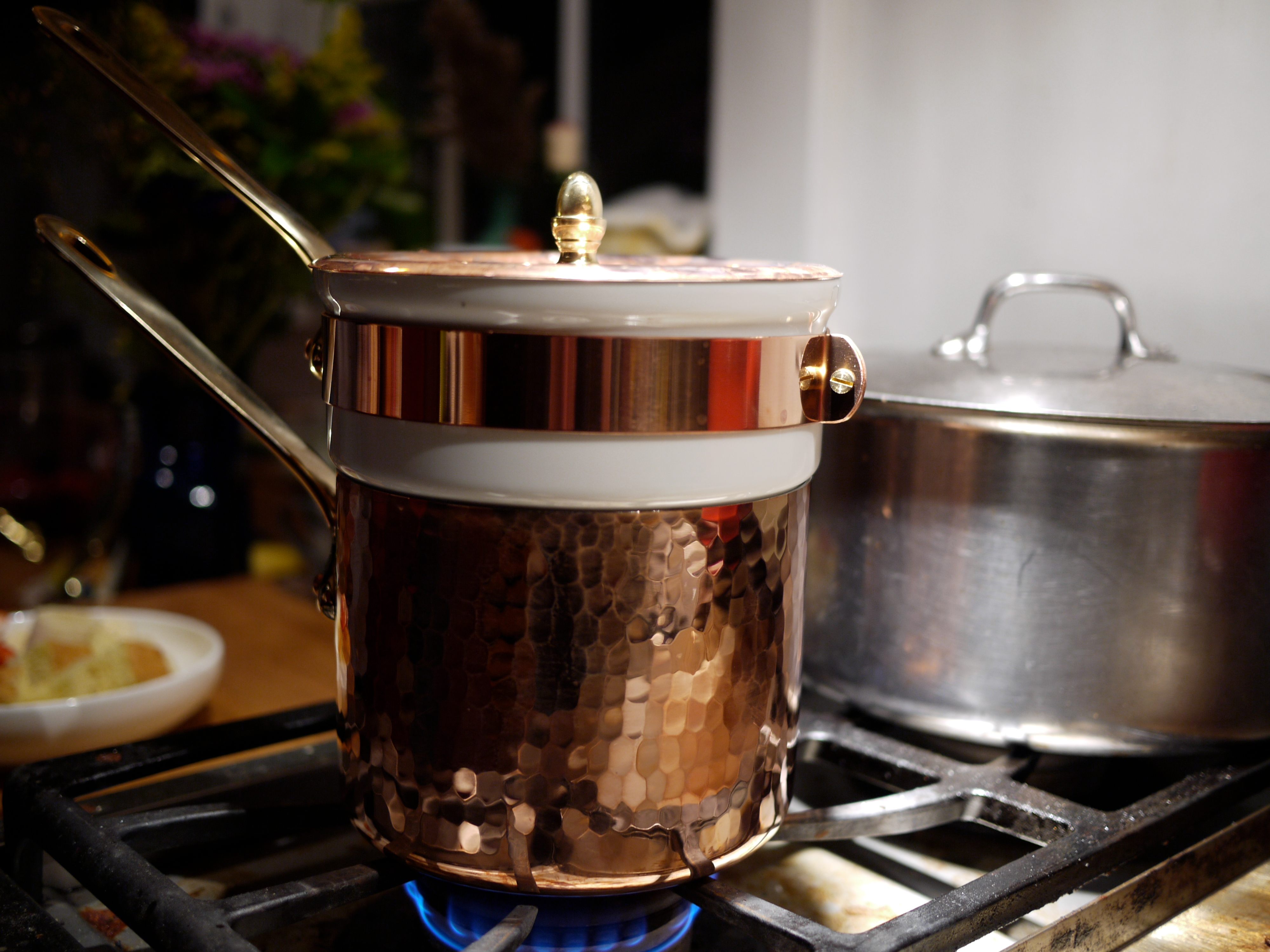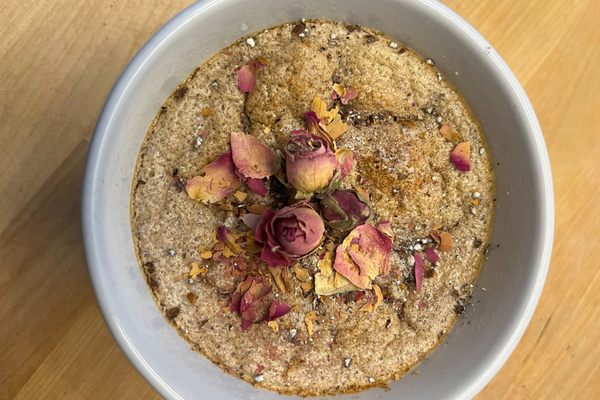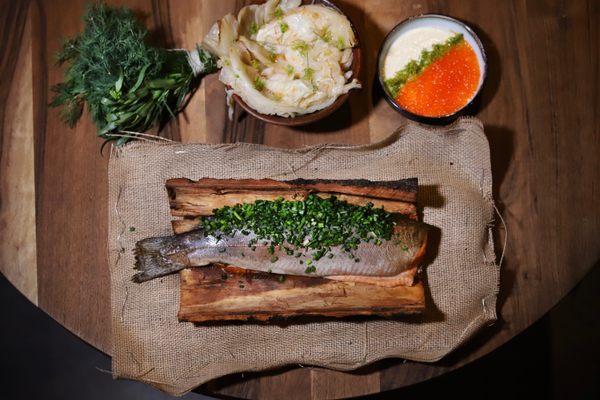The Ancient Female Alchemist Whose Name Is in Your Kitchen
Who put the Marie in “bain-Marie”?
THIS ARTICLE IS ADAPTED FROM THE APRIL 6, 2024, EDITION OF GASTRO OBSCURA’S FAVORITE THINGS NEWSLETTER. YOU CAN SIGN UP HERE.
If you want to melt chocolate chips into ganache, thicken a smooth, creamy hollandaise, or bake a custard that separates easily from your springform pan, you’ll need to deploy one of the most essential tools in the baker’s arsenal: the double boiler, also called the water bath or bain-Marie.
The bain-Marie, which is French for “Mary-bath,” helps to distribute heat gently and evenly. In addition to kitchens, it’s used in chemistry labs and in the production of soap, perfume, dye, and candles.
A bain-Marie consists of a set of two pans, one set inside the other. Ingredients are placed in the upper pan, and the lower pan is filled with water and heated over the stove. Home cooks can achieve a similar effect by placing a bowl over a pot of boiling water, or by baking one pan inside a pan full of water in the oven.
Because materials or ingredients in the bain-Marie are warmed indirectly by steam, cooking temperature is limited to water’s boiling point (212 degrees Fahrenheit at standard pressure). This makes the technique ideal for delicate ingredients that burn easily.
You might have used a bain-Marie yourself, and you’ve almost certainly eaten or used something that was made with one. But did you ever wonder who this mysterious Mary is, and why she was so keen on baths?
Theories abound: Is the bain-Marie named for the Virgin Mary? Maybe Marie Antoinette? But the most fascinating possibility connects the name to an Egyptian Jewish female alchemist. It’s a legend that goes back to the ancient Mediterranean, where science, magic, and cooking intertwined.

The First Water Baths
The water bath method was used by the Ancient Greeks to make medicine as early as the fifth century BC, appearing in the writings of Hippocrates. The earliest known recipe that uses a water bath is from the second century BC, when the Roman politician and agricultural writer Cato the Elder instructed readers to pour cheesecake batter “into an earthenware jar, plunge into a copper pot full of hot water, and boil over the fire.”
The most-complete Roman cookbook, Apicius, from the fifth century, features many souffle-like dishes cooked ad aquam calidam, Latin for “in the hot water.” Apicius also recommends a water bath for keeping prepared food warm if you aren’t sure what time your dinner guests will arrive. But these early references make no mention of any Mary. This is because “bain-Marie” was originally applied not to the water bath itself, but to a similar device found in the labs of early Mediterranean alchemists.
“The Divine Maria”
Before modern chemistry, there was alchemy: the semi-mystical practice of manipulating materials to understand their properties, with lofty goals like turning lead into gold or brewing the elixir of life. The Western alchemical tradition began in Alexandria, Egypt in the early first millennium, when Egypt was a Roman province with a long history of Greek influence.
There, around the year 300, the alchemist Zosimos wrote the earliest books on alchemy that have survived to this day, with many references to great alchemists who had come before him. One of these was a Jewish woman named Miriam (“Mary,” or “Maria” in Greek), whom Zosimos revered for her wisdom, calling her “the divine Maria” and “one of the sages.”
Alchemists deliberately cloaked their work in cryptic symbolism, so Zosimos is vague on details when it comes to these “sages;” he doesn’t even say how long before himself Maria lived. It’s possible that she existed—ancient Alexandria was home to a large Jewish population, and some Alexandrian women did practice alchemy, including Zosimos’s sister—but we can’t say anything about Maria with certainty.

Later sources fabricated details to fill in Maria’s biography. She has been described variously as a tutor of Greek philosophers; as a Coptic Christian living in the first century; and as the Biblical Miriam, sister of Moses. According to Zosimos, Maria invented several important early chemistry devices, such as the kerotakis, a high-temperature double boiler used to melt soft metals like copper or lead. The lower pan of the kerotakis contained mercury or sulfur, not water, but the device worked the same as a water bath, by maintaining material in the upper pan at the same temperature as the lower.
Zosimos’s claims were accepted and repeated by later alchemists. In the 13th century, the Catalan physician Arnold of Villanova made the first-known reference to a double boiler as “Mary’s bath,” using the Latin balneum Mariae. This was translated by other alchemist-authors into French, Italian, and Arabic. By the 17th century, bain-Marie had become the common term for the kerotakis, as well as for the water bath used in laboratories. From there, the term was applied to the similar water baths used for cooking.
As modern science developed in the 18th and 19th centuries, it changed the way that people cooked, and terminology like “bain-Marie” jumped from the laboratory into the kitchen. Some of the early modern food writers who used the term were well-aware that it came from chemistry. An English cookbook from 1818, which described the double boiler as “a mode of cookery that deserves to be more generally employed,” notes that “this in chemical technicals is called Balneum Maris, a Water Bath; in culinary, Bain Marie.”
If Maria existed, the culinary water bath may have predated her kerotakis. But over time, it took on the name of her invention for melting metals to discover the elixir of life. Maybe you don’t always feel like a scientist in the kitchen, but next time you use a double boiler, we wouldn’t blame you if you start to feel just a bit like an alchemist.

Where Can You Use a Bain-Marie?
Here’s a list of the culinary applications for “Mary’s bath”:
-
Gently warming cooked food, and keeping it warm for a long time without it drying out or burning.
-
Melting chocolate.
-
Making condensed milk or clotted cream.
-
Liquifying honey that has crystallized.
-
Baking soft, delicate dishes, like crème brûlée, soufflé, cheesecake, custard, and some terrines or pâtés. In the oven, a bain-Marie helps prevent the pan from becoming too hot, which can burn the edges of the dish and cause it to stick. The steam produced by a water bath also keeps the top of such dishes from drying and cracking as they bake.
-
Making creamy, high-fat sauces, especially those thickened with starch or eggs, such as hollandaise and some ice cream bases. Without the bain-Marie’s gentle heat, bits of egg or starch may cook more quickly than the rest of the sauce, creating a clumpy, curdled texture, or the fat in such sauces may separate.
-
Unmolding a set jelly or pudding. A few minutes in a water bath helps gelatinous dishes release from their mold in one piece. Powdered or sheet gelatin can also be melted evenly in a bain-Marie.
-
In southern Chinese cuisines like Cantonese and Fujianese, a similar technique called dun, or “double boiling,” is used to extract maximum flavor from delicate ingredients for soups.
Gastro Obscura covers the world’s most wondrous food and drink.
Sign up for our email, delivered twice a week.


























Follow us on Twitter to get the latest on the world's hidden wonders.
Like us on Facebook to get the latest on the world's hidden wonders.
Follow us on Twitter Like us on Facebook